Today might have been one of those days that people would point to as an example of why unCollege doesn't work. Which is silly, because I remember quite a bit more noodling around from my traditional college days. It would take three hours to write a paragraph for a paper because I was screwing around on Facebook and Youtube most of the time. So I was actually quite a bit more productive today than I would have been back in my undergrad days, even though I was feeling really lazy and didn't accomplish much compared to the other days.
Today's warm-up was a complete bust, as the assignment was to go through your best friend's stash. This would not be possible for me today, and even if it was I would feel pretty uncomfortable about it. I don't like it when people go through my things, so why would it be okay for me to do it to someone else? So I knitted instead. Being super-unproductive, I knitted about 4 rows before I quit.
I worked on my weaving while I listened to today's podcast. It was a continuation of yesterday's and talked about the rage for chintz (in the traditional sense of painted cotton) in Europe. It was crazy-popular in England, although it was relatively inexpensive so people who were trying to show off how rich they were would wear silk underneath. It was also very popular in Holland. It didn't make much of a splash in Italy or France. In England, rich women would give chintz clothes to their servants, so people complained that they couldn't tell what class people were by looking at them (the horror!). It started out being popular for bedspreads and that sort of thing, but then made its way to fashion, which led some to gripe about people wearing their bedsheets. Because it was so popular and relatively inexpensive, local cloth manufacturers were having a difficult time. Most cloth manufacturers in England were producing wool and linen cloth, which are much more difficult to clean than cotton. So the importation of chintz was outlawed. People were very creative in finding ways around the laws so chintz continued to be worn. Eventually European importers began to request certain themes or motifs on their chintz, which the Indian manufacturers would carry out. For example, trees were very popular in Holland.
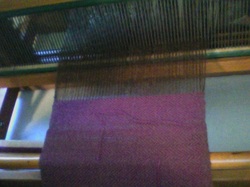
My weaving, which is not chintz.
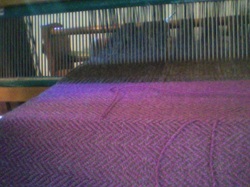
Note the herringbone pattern. I should also mention that I actually taught myself how to read a weaving pattern today. Mostly.
Next I worked on drawing. This was one of the assignments where I felt I was the laziest. I set up a very simple still life. Very simple. I think it took me 20 minutes to draw it. My last drawing took about five hours.
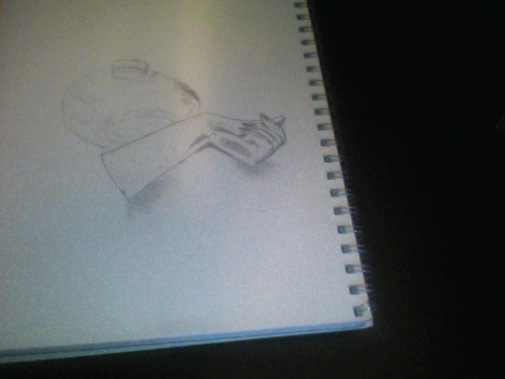
I promise I will take better photos one day. I want to scan this, but the scanner isn't talking to my computer. This should be indicative of my general technology-savviness.
I studied my design book after that. This unit was about other principles in 2-D design (harmony being the one that I looked at yesterday). I looked at variety, the counterpart to harmony. This could involve contrast, meaning opposition or dissimilarity. Contrast could be in color, value, or placement. Elaboration of an area that lacked visual interest is another way of achieving variety. Finally, one must take into account the dualism of harmony and variety. You could, for example, achieve harmony by repeating shapes, and variety by making those shapes different colors. Another principle is balance, which is what we perceive should happen with the objects in the work. For example, a picture of a ball at the top of a painting gives a sense of tension, as we expect the ball to fall down. Additionally, the way we perceive things, it doesn't look right when the mat around the painting is equal on all sides. Usually the bottom part will be a bit larger, which makes things seem more balanced. There are different kinds of balance: symmetrical balance, in which the two halves of the work mirror each other; approximate symmetrical balance, where equal visual weights are on both halves of the work, even though those halves aren't identical; and radial balance, where the visuals radiate out from a certain point on the work; asymmetrical balance, in which colors, shapes, lines, and negative area balance each other out (this I know when I see but don't know how to reproduce it myself). Next I looked at proportion, which is the relationship in placement in a work. The golden mean is a part of that, although I must admit that I don't really understand the golden mean and how it works. I understand that there is some sort of ratio that the shapes have to each other, but that's the extent of what I understand. Proportion could also mean the proportion of the work itself to the surrounding areas, or how much room the subject(s) of the painting take up within the picture frame. In ancient art, the most important figure would be the largest, with other figures smaller. Dominance is another principle. Dominance occurs when a figure or shape dominates the surrounding space, whether through size, color, value, or something else. Movement is the direction of the viewers eyes to different parts of the work. Artists can manipulate what order the viewer looks at the image in by placing points of interest in different places on the work. Economy is another principle of design, where the artist seeks to eliminate that which is unnecessary or confusing. Finally, there is the problem of space: what sort of visual plane the artist wants to appear on the work. A 2-D work with a flat plane is referred to as decorative and one with a deep plane is called three-dimensional or plastic.
Next, I worked on the dreaded task of removing the dye from my sample cloths. Some of the overdyes ended up being quite interesting.

Tie-dye without stones

Tie-dye with stones

Scrunching
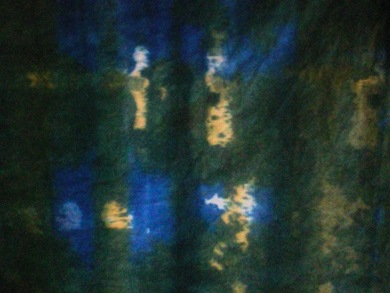
Pleated
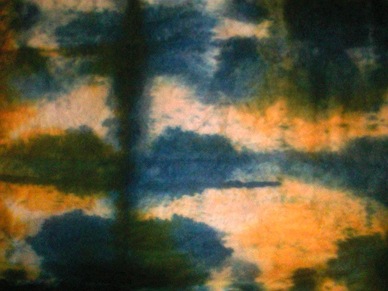
Folded. I like that this one kind of looks like ikat.
Finally, I worked on my business study. I am still trying to come up with numbers for my start-up costs. It is hard to get some straight answers about how much something will cost me. I'm also trying to figure out if I need a business license. I apparently don't need to be a citizen to sell at the Saturday market, but if I make over $15,000 a year I need a business license, and I don't know the legalities of that. I guess it's a good thing that I have to figure all that stuff out before I can get started and cost myself a pile of money or accidently break rules. But I've decided to figure out start-up and ongoing costs before I move to the next thing in the book. Otherwise I will get too confused. I really hate trying to figure money out but I also hate working for other people so I guess I'd better get over that!
I have filled in an application to volunteer at the Museum of Contemporary Craft. I will most likely be handling transactions or directing customers, but it will give me the chance to see how a gallery works. Besides, it's my favorite gallery in town. So I will keep you posted on my progress.
Yesterday, I forgot to mention that I got my very own unCollege student ID card! My wonderful friend Melanie Wallace, who has a laminator, made it for me. Thanks Mel!









 RSS Feed
RSS Feed
